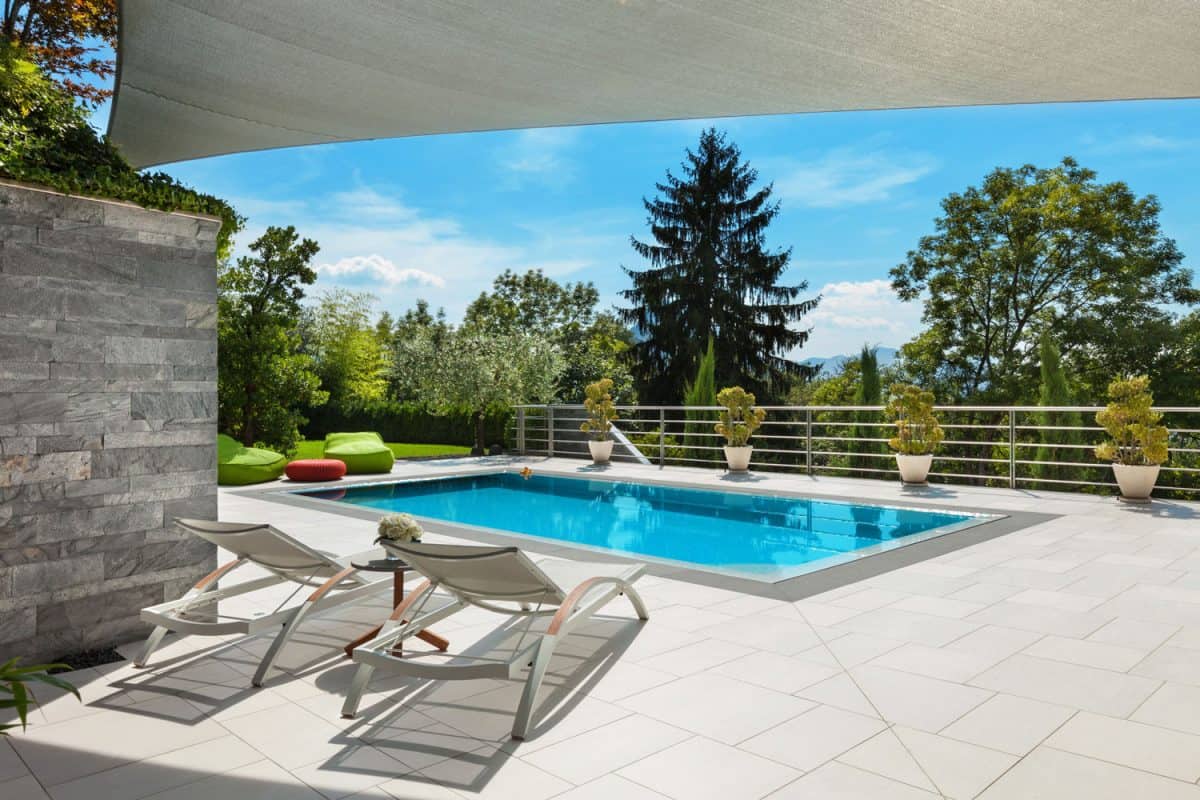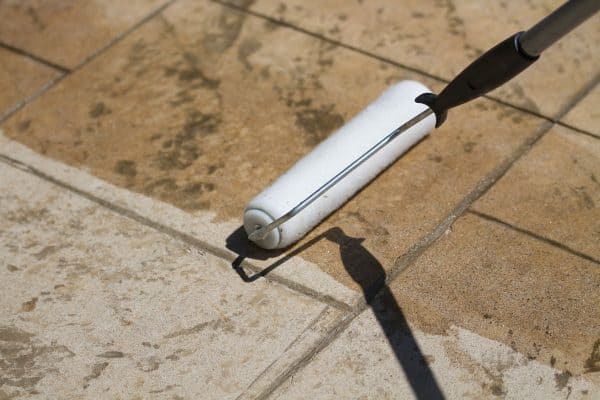Disclosure: We may get commissions for purchases made through links in this post.
Bluestone pavers are such an appealing paver choice - they're well worth your purchase. Now you've bought them and you want them installed over concrete, but you're not sure how. We've researched relevant steps on how to install bluestone pavers over concrete, and we're here to share with you what we've found!
Follow these steps to install bluestone pavers over concrete:
- Dry the surface. Prepare the concrete mixture by mixing sand, gravel, and water.
- Pour concrete on the area, then flatten it with a trowel.
- Lay bluestone pavers on top, leaving at least 0.25 inches between them. This helps avoid protrusion when pavers are moved by forces like foot or vehicle traffic.
- Seal the paver joints to enhance stability.
For many homeowners, concrete is known as a durable, long-lasting compound. However, it's a known fact that pavers can enhance the quality of concrete. Bluestone pavers alone are strong enough, but how much more if you install them over concrete? We'll give you more ideas about laying bluestone pavers over concrete. Keep reading with us!

What Is Bluestone?
Bluestone is a sedimentary rock that comes from different bodies of water, like seas, lakes, and rivers. Bluestone got its name simply because of the abundant minerals from various sources, such as hydrothermal energies, marine species, and other natural activities.
Because it's all-natural, bluestone can be very expensive, depending on the process of finding and cutting it. Bluestone is then modified into pavers to add quality to homes. However, bluestone pavers are best used with other compounds, like cement or sand, to make installation manageable.
Can Bluestone Pavers Be Installed on Existing Concrete?

There are things to consider when laying pavers on existing concrete. Assess the area and the concrete's condition. This will help you avoid mistakes that may cause major problems. Be mindful of things you should do and things to avoid. See the list of do's and don'ts below:
Do's:
- Ensure that the surface is clean and dry.
- Check for leakages and minor issues before installation.
- Keep in mind that you still need a bonding agent, like a mortar mixture, to keep the pavers stable and safe.
- Repair any damage to maximize the concrete's efficiency.
- Measure the area and estimate the size of the pavers. You'll need this for cutting excess from the edges.
- Find someone to help you perform the task, especially if the area is large.
- Seal the paver joints.
- Consult an expert for further assessments.
See this edge shaping tool on Amazon.
Don'ts:
- Don't install on rainy days. This will ruin the process.
- Never leave cracks in concrete unrepaired. More serious issues, such as misaligned pavers or sinking, may arise.
- Don't lay defective pavers, like those with damaged corners and edges.
- Don't rush the installation. Normally, it takes 1–3 days or longer to install pavers, depending on the size of the area. Just be sure to cover it with a tarpaulin cover and keep children away from the area.
See this outdoor tarpaulin cover on Amazon.
How to Apply Concrete Base?

The concrete base is the layer beneath the pavers meant that's meant to bond them to the ground. You need sand, gravel, and water to create the concrete mixture. It's important that you layer the concrete base evenly to avoid misaligned pavers.
Follow these steps:
- Ensure the area is clean and dry.
- In a bucket, mix the sand, gravel, and water. Blend them until you feel the mixture becoming moderately hard to stir.
- Apply and level the mixture to the area using a trowel.
- Proceed to install bluestone pavers before the concrete hardens.
How Thick Concrete Base Should Be?
Ideally, the thickness of the concrete base should be 2-4 inches. The concrete base is meant to act as an adhesive beneath the pavers. It doesn't need to be thicker than six inches because laying bluestone pavers on top will already increase the ground's level. Additionally, a too-thick concrete base might be harder to fix.
Bluestone Pavers for Other Concrete Surfaces

Bluestone pavers are suitable for indoor use. They can protect your home from the dusty concrete floor. Unlike outdoor areas, you don't need sand for pavers indoors. Instead, you will need to use use grout to seal paver joints. However, you'll need professional assistance if you're planning to use them indoors.
Below are some good locations for bluestone pavers indoors:
Bedroom

Bluestone pavers age well and look great in a bedroom. Their relaxing appeal can add comfort to your room. You just need to ensure the concrete base is in good condition. You'll need grout to seal the paver joints in the bedroom areas.
Bathroom

The bathroom is another good place to have bluestone pavers. Take note, though, that bluestone pavers might become slippery in the bathroom since it's usually wet. However, you can place a rubber mat to increase friction and lessen the risk of slipping.
See this non-slip rubber mat on Amazon.
Dining Area
Bluestone pavers are elegant in the dining area. Your visitors may be amazed while you eat together. The dining area typically has chairs and tables, which may scratch the pavers. As part of maintaining the pavers' quality, lift chairs and tables when moving them instead of dragging them.
See this silicon corner protection on Amazon.
Pool

A pool and bluestone pavers are a good combination. Just keep in mind that bluestone pavers need to be dried more often when installed around pools, as they may be too slippery due to mineral content. However, you can prevent a slippery surface with liquid rubber sealant.
See this liquid rubber sealant on Amazon.
How to Seal Bluestone Pavers on Concrete?
It's important to keep the pavers in place. This contributes to the safety of homeowners in many ways, including improving the surface texture and reducing dirt. Before sealing, make sure you used sand to fill the joints.
Prepare the following tools you'll need:
- Dry broom
- Gloves and mask
- Hammer
- Water
- Paver sand
See this sand broom on Amazon.
A dry broom is for sweeping sand. You'll need to wear gloves and a mask to ensure safety during the sealing process. Water helps harden the sand between pavers. And, of course, you'll need paving sand.
Now, continue to these steps:
- Wear gloves to avoid skin irritation and a mask to prevent inhaling the sand.
- Apply sand, then spread it with a dry broom throughout the area. Make sure you fill the joints tightly.
- Wash the pavers gently with water. This will cause the sand to settle and bond the pavers together.
See this polymeric sand on Amazon.
When the pavers are dried, apply a latex, acrylic, or water-based sealant to enhance protection against fading. You may use a clear sealant to retain the original colors of the bluestone.
See this stone sealant on Amazon.
How Long Do Bluestone Pavers Last?

With proper installation, sealing, and cleaning, bluestone pavers can last for up to 50 years or more. The durability of bluestone can probably surpass concrete because bluestone is a natural stone while concrete is a mixed compound.
Although bluestone pavers are more expensive than concrete, they are a long-term investment that will save you a lot of money in repair costs. A plain concrete floor can also last up to 50 years, but you'll need more effort to retain its quality.
Can You Cut Bluestone Pavers?
Cutting bluestone pavers is easy with an angle grinder, which is typically used for shaping stone pavers with a sharp disk. However, there are things to keep in mind when cutting stone pavers, such as measurement and depth of cut. You need to cut the excess edges of pavers when you install them.
See this multi-purpose angle grinder on Amazon.
Cutting stone pavers releases dust. Wear a mask to avoid inhalation.
To start cutting, follow these steps:
- Draw the line you need to cut.
- Clamp the paver to avoid it moving while you cut.
- Use sandpaper to smooth the edges.
See this steel clamp on Amazon.
Are Bluestone Pavers Heat-Resistant?
Compared to other stone pavers, bluestone is highly resistant to heat. That's why bluestone is expensive, aside from being durable. However, bluestone pavers can still get hot when exposed to the sun for a long time. Additionally, bluestone pavers are more tolerable when they heat up. This is because of the sea minerals and nutrients present in them.
Conclusion

Concrete alone might be darker and harder to clean. With bluestone pavers, you can significantly increase the concrete's lifespan. Just be mindful of installation steps and other facts to enhance durability.
Want to learn more? You may find these articles relevant:
Is Stamped Concrete Hard To Maintain? [And How Long Does It Last? ]
Is Crushed Concrete A Good Paver Base? Considering The Pros & Cons For Your Hardscape?











![Vibrant Red Paver Stone Path, Can You Spray Paver Sealer? [How To Apply It]](https://pavingplatform.com/wp-content/uploads/2022/04/Vibrant-Red-Paver-Stone-Path-600x400.jpg)
![Properly laid out red pavers for a garden, Can You Tint Paver Sealer? [And How To]](https://pavingplatform.com/wp-content/uploads/2022/04/Properly-laid-out-red-pavers-for-a-garden-600x400.jpg)
